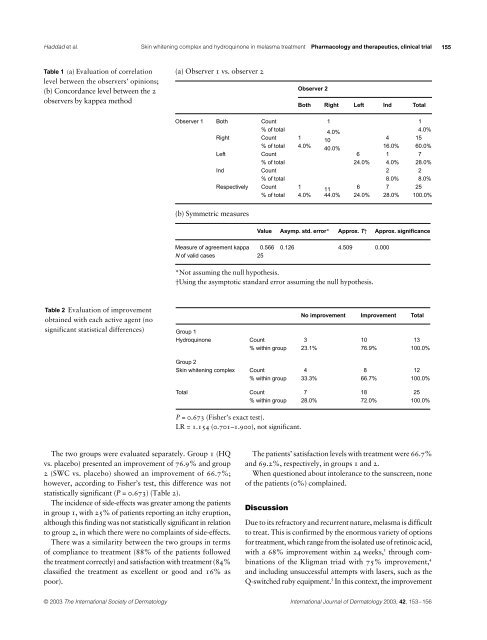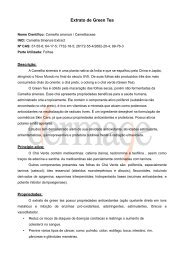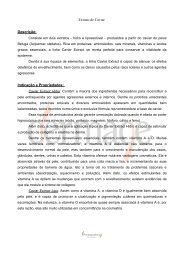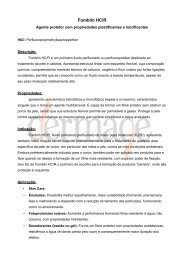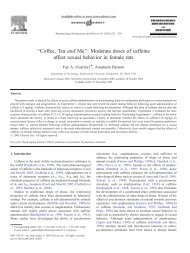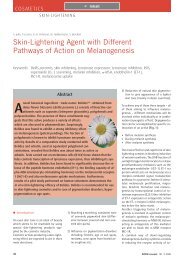Pharmacology and therapeutics, clinical trial - Dermage
Pharmacology and therapeutics, clinical trial - Dermage
Pharmacology and therapeutics, clinical trial - Dermage
You also want an ePaper? Increase the reach of your titles
YUMPU automatically turns print PDFs into web optimized ePapers that Google loves.
Haddad et al. Skin whitening complex <strong>and</strong> hydroquinone in melasma treatment<br />
Table 1 (a) Evaluation of correlation<br />
level between the observers’ opinions;<br />
(b) Concordance level between the 2<br />
observers by kappea method<br />
Table 2 Evaluation of improvement<br />
obtained with each active agent (no<br />
significant statistical differences)<br />
(a) Observer 1 vs. observer 2<br />
(b) Symmetric measures<br />
The two groups were evaluated separately. Group 1 (HQ<br />
vs. placebo) presented an improvement of 76.9% <strong>and</strong> group<br />
2 (SWC vs. placebo) showed an improvement of 66.7%;<br />
however, according to Fisher’s test, this difference was not<br />
statistically significant (P = 0.673) (Table 2).<br />
The incidence of side-effects was greater among the patients<br />
in group 1, with 25% of patients reporting an itchy eruption,<br />
although this finding was not statistically significant in relation<br />
to group 2, in which there were no complaints of side-effects.<br />
There was a similarity between the two groups in terms<br />
of compliance to treatment (88% of the patients followed<br />
the treatment correctly) <strong>and</strong> satisfaction with treatment (84%<br />
classified the treatment as excellent or good <strong>and</strong> 16% as<br />
poor).<br />
<strong>Pharmacology</strong> <strong>and</strong> <strong>therapeutics</strong>, <strong>clinical</strong> <strong>trial</strong><br />
The patients’ satisfaction levels with treatment were 66.7%<br />
<strong>and</strong> 69.2%, respectively, in groups 1 <strong>and</strong> 2.<br />
When questioned about intolerance to the sunscreen, none<br />
of the patients (0%) complained.<br />
Discussion<br />
Observer 2<br />
Both Right Left Ind Total<br />
Observer 1 Both Count 1 1<br />
% of total<br />
4.0%<br />
4.0%<br />
Right Count 1<br />
10<br />
4 15<br />
% of total 4.0%<br />
40.0%<br />
16.0% 60.0%<br />
Left Count 6 1 7<br />
% of total 24.0% 4.0% 28.0%<br />
Ind Count 2 2<br />
% of total 8.0% 8.0%<br />
Respectively Count<br />
% of total<br />
1<br />
4.0%<br />
11<br />
44.0%<br />
6<br />
24.0%<br />
7<br />
28.0%<br />
25<br />
100.0%<br />
Value Asymp. std. error* Approx. T† Approx. significance<br />
Measure of agreement kappa 0.566 0.126 4.509 0.000<br />
N of valid cases 25<br />
*Not assuming the null hypothesis.<br />
†Using the asymptotic st<strong>and</strong>ard error assuming the null hypothesis.<br />
No improvement Improvement Total<br />
Group 1<br />
Hydroquinone Count 3 10 13<br />
% within group 23.1% 76.9% 100.0%<br />
Group 2<br />
Skin whitening complex Count 4 8 12<br />
% within group 33.3% 66.7% 100.0%<br />
Total Count 7 18 25<br />
% within group 28.0% 72.0% 100.0%<br />
P = 0.673 (Fisher’s exact test).<br />
LR = 1.154 (0.701–1.900), not significant.<br />
Due to its refractory <strong>and</strong> recurrent nature, melasma is difficult<br />
to treat. This is confirmed by the enormous variety of options<br />
for treatment, which range from the isolated use of retinoic acid,<br />
3<br />
with a 68% improvement within 24 weeks, through com-<br />
4<br />
binations of the Kligman triad with 75% improvement,<br />
<strong>and</strong> including unsuccessful attempts with lasers, such as the<br />
5<br />
Q-switched ruby equipment. In this context, the improvement<br />
© 2003 The International Society of Dermatology International Journal of Dermatology 2003, 42,<br />
153–156<br />
155


